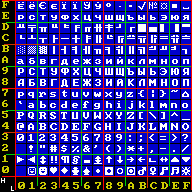Related Research Articles
ISO/IEC 8859-11:2001, Information technology — 8-bit single-byte coded graphic character sets — Part 11: Latin/Thai alphabet, is part of the ISO/IEC 8859 series of ASCII-based standard character encodings, first edition published in 2001. It is informally referred to as Latin/Thai. It is nearly identical to the national Thai standard TIS-620 (1990). The sole difference is that ISO/IEC 8859-11 allocates non-breaking space to code 0xA0, while TIS-620 leaves it undefined.
ISO/IEC 8859-8, Information technology — 8-bit single-byte coded graphic character sets — Part 8: Latin/Hebrew alphabet, is part of the ISO/IEC 8859 series of ASCII-based standard character encodings. ISO/IEC 8859-8:1999 from 1999 represents its second and current revision, preceded by the first edition ISO/IEC 8859-8:1988 in 1988. It is informally referred to as Latin/Hebrew. ISO/IEC 8859-8 covers all the Hebrew letters, but no Hebrew vowel signs. IBM assigned code page 916 to it. This character set was also adopted by Israeli Standard SI1311:2002, with some extensions.
Windows-1258 is a code page used in Microsoft Windows to represent Vietnamese texts. It makes use of combining diacritical marks.

Code page 866 is a code page used under DOS and OS/2 in Russia to write Cyrillic script. It is based on the "alternative code page" developed in 1984 in IHNA AS USSR and published in 1986 by a research group at the Academy of Science of the USSR. The code page was widely used during the DOS era because it preserves all of the pseudographic symbols of code page 437 and maintains alphabetic order of Cyrillic letters. Initially, this encoding was only available in the Russian version of MS-DOS 4.01 (1990) and since MS-DOS 6.22 in any language version.
Windows-1254 is a code page used under Microsoft Windows, to write Turkish that it was designed for. Characters with codepoints A0 through FF are compatible with ISO 8859-9, but the CR range, which is reserved for C1 control codes in ISO 8859, is instead used for additional characters. It is similar to ISO/IEC 8859-1 except for the replacement of six Icelandic characters with characters unique to the Turkish alphabet.
Windows-1255 is a code page used under Microsoft Windows to write Hebrew. It is an almost compatible superset of ISO-8859-8 – most of the symbols are in the same positions, but Windows-1255 adds vowel-points and other signs in lower positions.
Windows-1256 is a code page used under Microsoft Windows to write Arabic and other languages that use Arabic script, such as Persian and Urdu.
Windows-1257 is an 8-bit, single-byte extended ASCII code page used to support the Estonian, Latvian and Lithuanian languages under Microsoft Windows. In Lithuania, it is standardised as LST 1590-3, alongside a modified variant named LST 1590-4.
Code page 857 is a code page used under DOS in Turkey to write Turkish.
Code page 862 is a code page used under DOS in Israel for Hebrew.

Code page 950 is the code page used on Microsoft Windows for Traditional Chinese. It is Microsoft's implementation of the de facto standard Big5 character encoding. The code page is not registered with IANA, and hence, it is not a standard to communicate information over the internet, although it is usually labelled simply as big5, including by Microsoft library functions.
Code page 864 is a code page used to write Arabic in Egypt, Iraq, Jordan, Saudi Arabia, and Syria.
Code page 856, is a code page used under DOS for Hebrew in Israel.
Code page 868 is a code page used to write Urdu in Pakistan.
Code page 896, called Japan 7-Bit Katakana Extended, is IBM's code page for code-set G2 of EUC-JP, a 7-bit code page representing the Kana set of JIS X 0201 and accompanying Code page 895 which corresponds to the lower half of that standard. It encodes half-width katakana.
Code page 1098 (also known as CP 1098, IBM 01098, is a code page used to write Persian in Iran.
Code page 921 is a code page used under IBM AIX and DOS to write the Estonian, Latvian, and Lithuanian languages. It is an extension of ISO/IEC 8859-13.
Code page 922 is a code page used under IBM AIX and DOS to write the Estonian language. It is an extension and modification of ISO/IEC 8859-1, where the letters Ð/ð and Þ/þ used for Icelandic are replaced by the letters Š/š and Ž/ž respectively. This matches the encoding of these letters in Windows-1257 and ISO/IEC 8859-13.
Code page 1043, also known as Traditional Chinese PC Data Extended, is a single byte character set (SBCS) used by IBM in its PC DOS operating system. This code page is intended for use with code page 927. It is an extension of Code page 904.
Code page 1115, also known as Simplified Chinese PC Data, is a single byte character set (SBCS) used by IBM in its PC DOS operating system in China.
References
- ↑ "CCSID 867 information document". Archived from the original on 2016-03-27.
- ↑ "Code page 867 information document". Archived from the original on 2017-01-16.
- ↑ Code Page CPGID 00867 (pdf) (PDF), IBM
- ↑ "Code Page (CPGID) 00867: Israel - Personal Computer". REGISTRY, Graphic Character Sets and Code Pages. IBM Corporation. 1998. Retrieved 2014-06-02.[ permanent dead link ]